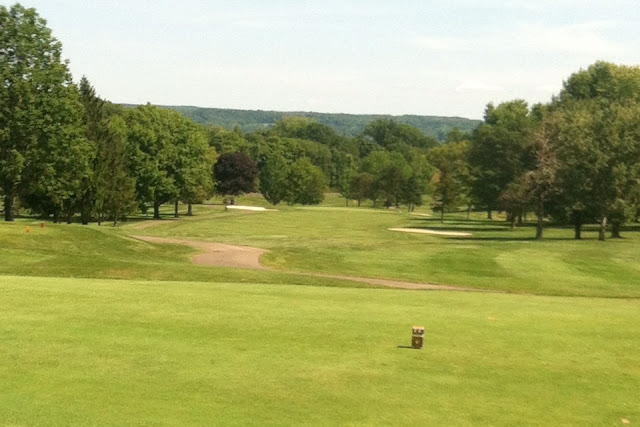(The par four eighth is one of six par fours that doglegs left. The green is protected short by sand, but the player should have no problem carrying it.)
I typically play the North. I think it has great green complexes, beautiful bunkering, and a good routing. (7-10-14 review) The South course however gets all the accolades when the regulars discuss which is the better track. It's a premise I never understood. And after playing it last weekend, I'm even more convinced it's the lesser of the two.
(The 450 yard opening hole emphatically introduces itself to the golfer.)
The pride of the South is it's long par fours, specifically one, nine, ten, and eighteen. The first hole is 450 yards, a perfect example of Ross' firm handshake philosophy.
(The 438 yard ninth is a great hole! It doglegs just a bit the last fifty yards, so the second gets blocked out by the crossbunker unless the drive is down the right side.)
(The tenth is 426 yards. It's small green is bracketed by bunkers.)
(The 424 yard eighteenth slightly doglegs left to an elevated green. Bunkers front right and front left narrow the entrance to the putting surface. Note the avenue of trees on both sides. Accuracy is a premium on this final hole.)
While these four holes are very good, there are several reasons why I prefer the North. The South has bigger greens, and they don't have the internal contours like the North. If you're driving straight, then it's not too difficult to put it on.
(The par five fourth is my favorite hole. It double doglegs right, the second time past the bunkers in pic. The green can be seen just ahead. If one drives it up the left, then it's possible to give the second shot a go!)
The South is also heavily tree-lined, so the fairways are thin. These are mature trees so air flow and sunlight issues are present. The rough especially can be sparse.
(The crossbunkered par three seventh is nearly 200 yards. The tee shot is in a canopy of trees, as is the entire hole, or so it seems.)
Then there's the dogleg par fours. Four of them turn close to ninety degrees, and with these huge trees, they have an awkward look. It takes discipline to look away from the inside corner, and more to the 150 marker.
(The beautiful par three thirteenth has a gaping bunker front left.)
(The seventeenth share the tee with thirteen. It looks similar but a grass bunker guards the front right instead.)
The South is par 70, and the two par fives are both very good. The aforementioned fourth doglegs twice with the crossbunkers forcing the action on the second shot. The fourteenth is slightly uphill and reachable with two big shots.
(The fourteenth is 516 yards. The bunker straight ahead disrupts the view of the second shot, causing a little uncertainty as the golfer hits his second shot.)
(The view of the 411 yard eleventh from the twelfth tee. Note how it's slightly built up. No big drop offs behind or to the sides.)
At 6500 yards, the South can play as difficult as any in the Youngstown area. I assume that's the reasoning behind the locals glowing reviews. It definitely is a challenging course, and regardless of my preference for the North, it's a solid 5 (good)(worth driving an hour). With both courses at Millcreek being a five, anyone looking to play 36 holes should consider coming here. As I mentioned in the other review, Millcreek is a muni so conditions can be spotty. I have no problem overlooking such things, so I always have a good time.

















































